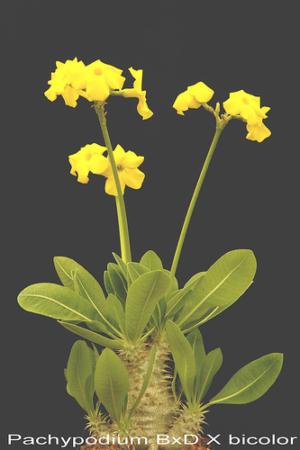Pachypodium bicolor
(Pachypodium bicolor)

Description
Pachypodium bicolor belongs to the dogbane family Apocynaceae, now merged with the milkweed family Asclepiadaceae, a move with great botanical implications to succulent enthusiasts. The species has a habit of a low growing somewhat pendulant shrub with a thickened trunk and a densely branched crown composed of numerous branches. It has been elevated from a "forma" taxonomical ranking of Pachypodium rosulatum variety rosulatum forma bicolor to a full species by Lavranos and Rapanarivo in 1997. A "forma" is a specific taxonomic ranking below subspecies and usually designates the smallest degree in taxonomical nomenclature recording the slightest difference between taxa, typically based on one chief character. It chief character that distinguishes Pachypodium bicolor from other species with yellow corolla is the presence of a white corolla tube or throat to the flower. Pachypodium bicolor is part of the Pachypodium rosulatum complex, where discussion centers on rather one is dealing with one species with many varieties, as Gordon Rowley argues, or many separate distinct species. The corolla, the collective term for the petals of a flower or the inner whorl of the perianth, in the nexus for taxonomical confusion of the taxon. Pachypodium bicolor is endemic to Madagascar in the low, open, deciduous, western forest growing on porous sandstone. The geological preference of Pachypodium bicolor is limited to one substrate. This makes it prefer a more specialized geological environment. Cultivation should stimulate this substrate. It does not have a common name in the native tongue to Malagasy—from Madagascar. Distribution to Madagascar. East of Belo sur Tsiribihina. Partly pendulant, Pachypodium bicolor forms a low shrub with a thickened trunk and a densely branched crown, the upper part of a tree or shrub, which includes the branches and leaves. Pachypodium bicolor is positioned on porous sandstone where it grows only in full sunlight. With an emphasis on openness, it is found in low open deciduous western forest. It grows at an altitude of approximately 30 m (98 ft). The limitation to one substrate, a low altitude in the landscape, suggests that Pachypodium bicolor has developed a specialized landscape-environmental condition that should affect its horticulture. Other plants that can be found around it, species indicators, are Euphorbia aff. pedilanthoides, E. viguieri (Euphorbiaceae), Uncarina leandrii var. rechbergeri (Pedaliaceae), Aloe sp., (Asphodelaceae) (Orchidaceae) (0.09 by 0.04 inch) Orchids sp. (0.09 by 0.04 inch) and Kalanchoe spp. (Crassulaceae).
Taxonomic tree:







